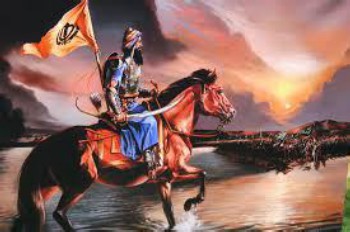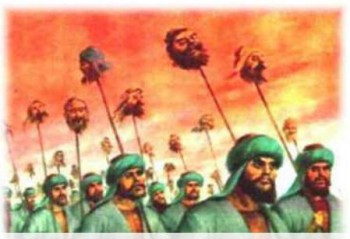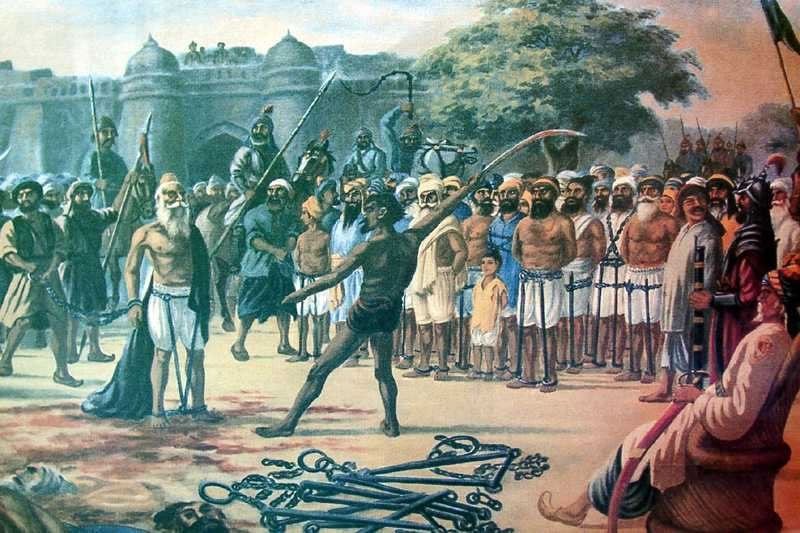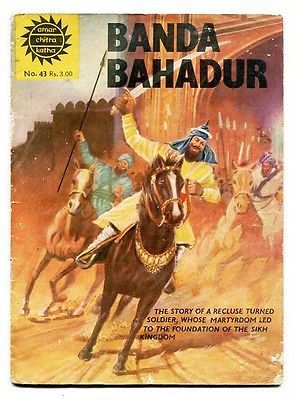The tragedy of Banda Bahadur
July 03, 2016: 300 years ago, almost to this day; 9th June 1716 to be exact, he was killed. Captured in December 1715, he was being tortured endlessly for over five months now. Over the days he had seen thousands of his men being beheaded before his own eyes, their heads mounted on spears and paraded in a procession.
 |
| As Madho Das, the ascetic |
This man, Banda Bahadur had had a glorious life. Once an ascetic called Madho Das (and earlier known as Lachhman Dev before ascetism), he had been given the sword and five arrows by the tenth Sikh Guru, and was given a mission to unite the Sikhs and liberate the Punjab from the atrocities of the Mughals.
He had raised an army of over 50,000 people comprising Sikhs, Hindus and even Muslims. His army defeated the mughal army across North India and gradually liberated a large part of Punjab and the area between the Ganga and Jamuna in the area that is now known as Uttar Pradesh. He decimated the Nawab of Sirhind, the nawab who had bricked alive the children of Guru Gobind Singh in a wall at Sirhind and avenged the children’s murder.
 |
| A painting of Banda Bahadur by Kanwar Singh |
 |
| A coin minted issued by Banda Bahadur – “Degh Tegh Fateh Nusrat Be-Darang; Yafat Ajj Nanak, Guru Gobind Singh” |
The Mughal emperor Bahadur Shah was in panic, the Sikhs were at the doorsteps of Delhi, just biding their time. It was for the first time in North India that a power had shattered the invincibility of the Mughals.
It was going well for Banda , and he was turning into a chief of prominence. There are many narratives here in history, and it is here that history becomes fudgy. He was initially a Yogi ascetic who had taken up arms to avenge the murder of Guru Gobind Singh’s sons. His army was made up of Nihangs, the traditional Sikh armies of Taruna Dal and Buddha Dal, the Tat Khalsa and the Khalsa who believed in the Gurus but were not fully following the Sikh code (which they now call the Bandai Khalsa).
As has been the story across India, it so happened that a portion of his own Sikhs started murmuring discontent against his regal lifestyle. The orthodox strain of Sikhs, the Tatt Khalsa started a campaign accusing him of digressing from the path of the Gurus.
Guru Gobind Singh’s widow – Mata Sundari Ji living in Delhi at that time – perhaps at the instigation of Banda’s detractors, perhaps as a result of intrigue by the Mughal emperor, is said to have been convinced that Banda was plundering the Punjab countryside. She wrote to Banda Bahadur; an order, a ‘Hukamnama’ asking him cease from pillaging the country side and settle down with their jagirs; the hukumnama being appended to a letter from the Mughal emperor. It is not known whether the hukamnama was authentic or not; however it was the beginning of the first tragic schism inside Sikhism.
Banda was contemptuous of the king’s offer and replied to Mata: “You want us to be subservient to those Turks who have destroyed your entire family. You are not aware of their cheating tactics. They will not give us property, they will merely deceive us. They want to weaken us through this sort of diplomacy.” Banda thus refused to toe the line of Guru Gobind Singh’s widow. The Tatt Khalsa, who looked upon Mata Sundari as their leader in the absence of Guru Gobind Singh took it as a personal affront to the Mata.
Mata Sundari is said to have thereafter issued another Hukamnama to the Sikhs, wherein she ordered Sikhs of the Panth to dissociate themselves from the man who had disobeyed the order of their Guru’s Spouse and had replied in rather insolent terms to her (“Banda Bahadur” by Sohan Singh) . No copy of this Hukamnama has existed and no one knows if it was genuine or a forgery on the orders of Farukh Siyar. The fact is that Mata Sundari’s supposed Hukumnama set in motion the wheels of the defeat of Banda . The Khalsa started deserting Banda Bahadur’s forces.
The Mughal army sensing the opportunity, attacked him led by the Lahore Governor. Banda fortified himself in a fort near Gurdas Pur, in a fort called Kacchi Garhi encircled by lacs of mughal warriors. The mughal seige of Banda continued for days, and months. Day by day conditions worsened in the Garhi. No food was left, grass, leaves of plants and trees were boiled and eaten. Even balk of trees was eaten. History was being created, a tragic history, but there was no one to write. They were completely cut off from the outside world. In the midst of the eight month long seige of the fort, the mighty Akalis, lead by Akali Nihang Baba Binod Singh and his son, Akali Nihang Baba Kahn Singh deserted him; supposedly in protest of him having forsaken the Sikh ideals.
It is said that as he saw his own Sikhs deserting him, Banda lost the will to fight. He had a couple of thousand men left with him, surrounded by lakhs. But this time there was no Muktasar, no charge by the sparrows on the eagles; Banda’s handful of Sikhs waited for the mughals to charge them; and as the mughals finally entered the fort, thousands were massacred, around 750 were captured alive, along with Banda Bahadur and his family. It is said Banda Singh made one last stand and killed about 50 to 60 soldiers of the Mughal army with his own hands before he could be captured, but others say that his deceived heart was just not into the fight, he refused to pick the sword and was captured alive; something that no Sikh warrior earlier had contemplated.
The Sikhs were brought to Delhi in a procession with the 780 Sikh prisoners, 2,000 Sikh heads hung on spears, and 700 cartloads of heads of slaughtered Sikhs used to terrorize the population. The Mughal caravan carrying Banda from Lahore to Delhi had captured and killed Sikhs along the route and hence the procession of Sikh prisoners was a sizeable one. The captured Sikhs were paraded to Delhi in a procession; and were asked to convert to Islam or perish. Banda was made to watch as hundreds were killed, their heads hung over spears and rolled like footballs on the streets of Delhi.
 |
 |
| (Left) The execution of Sikhs and (Right) Sikh heads on spears as Mughals march with Banda | |
None of the Bandai Khalsas gave up their religion, none of them bent down, and all of them kept on reciting the Sikh Jaikara even as they faced death.
The Tatt Khalsa, who after Mata Sundari’s hukumnama had forsaken Banda Bahadur watched from the shadows, feeling despondent and guilty. They are said to have lamented their mistake, and some are even said to have given themselves up for sacrifice to accompany their ex-comrades. But by then it was all over, the glory of Banda was over, his rule had been decimated, and he was a prisoner of the emperor.
Finally, after five months of imprisonment, the day of his killing had come. But before he was killed he was forced to draw a dagger into his own son, his six year old son sitting in his lap. The Nobel Prize winning Rabindra Nath Tagore has poetically expressed the moments in his poem "Bandi Bir"
In mere teen was the boy,
With hands tied thrown as a toy
Into the lap of Banda and without a word
He drew him close to his heart.
For a while he put his hand on his head,
Just once kissed his turban red.
He then draws his dagger,
Whispers in the child’s ear –
“Wahe Guru- fear not my son”
A virile in the boy’s face did burn –
In his juvenile voice the court did ring
“Wahe Guru” as he did sing.
With his left hand Banda held the boy,
With right struck the dagger in his ploy,
“Wahe Guru”, was all he did implore
As he took to the floor.
banda_bahadur-executions
 |
| He stood tall, his son watching him in chains. |
The pounding heart of his son was taken out by the executioner and pushed into his mouth. And as Banda resisted, his eyes were gouged out.
I first read Banda Bahadur’s story as a child, in historical comics of the Amar Chitra Katha. We used to read stories of Mughal atrocities, and often thought, well this has got to be an exaggeration, of course. I saw paintings depicting the tortures of Banda Bahadur in a Sikh Museum at Amritsar. No one could be so cruel, could it be! But apparently they could be so cruel, I believe it now after seeing a video of the ISIS butchers mercilessly severing the head of their captives, laughing and dancing around him, I am tempted to share and compare the Banda torture paintings and ISIS butchery pics here, but they can’t be unseen and I wouldn’t want to haunt my friends with such pictures or paintings.
But back to the last moments of Banda Bahadur, as his eyes were gouged out, his flesh was stripped off his body, his limbs cut-off one by one and finally he was killed.
Herein lies the story of the tragedy. He was most probably the first victim of the Divide amongst Sikhs. He was defeated not because the Mughals were better than him on that day, he was defeated because the Sikhs fought amongst themselves and deserted him. He proved his Sikh credentials and ideals with his death, when he refused to bow down to the mughal emperor, refused to accept Islam and died with dignity and his pride intact.
Today we say that Banda was overwhelmed with false pride and became arrogant and so he lost the grace of the Gurus. His mistreatment of the Khalsa, and alterations of the Guru-ordained Khalsa traditions, resulted in the Khalsa warriors loosing respect for him. It is said that Banda lost because he had declared himself a Guru, advocated teetotalism (a throwback to his earlier life as a Vairagi), altered the Khalsa salutation, stopped wearing blue, etc; though there is no conclusive evidence to give support to this argument.(www.sikhiwiki.org/index.php/Bandai_Khalsa)
Whatever be the case for his downfall, Banda proved his detractors wrong with his conduct during his torture, he proved to be a better Sikh than others that had deserted him in the midst of the seige. Mata Sundari though after the death of Banda Bahadur brokered a peace agreement between Bandai Khalsa and Tatt Khalsa. The Bandai Khalsa however later withered away, and the prominent stream that survived was the Tatt Khalsa.
 Today the Sikh orthodoxy, drawing their strength from Tatt Khalsa philosophy, bows to his memory, celebrates his glorious conduct during his execution but, and there is a big ‘but’; they refuse to accept that their own foolishness and mutual mistrust killed Banda; they still spend bytes of electronic space justifying the actions of the deserters; they still refuse to accept that it was their narrow vision that killed Banda; they still refuse to accept that Sikhs themselves were responsible for ending the reign of Banda.
Today the Sikh orthodoxy, drawing their strength from Tatt Khalsa philosophy, bows to his memory, celebrates his glorious conduct during his execution but, and there is a big ‘but’; they refuse to accept that their own foolishness and mutual mistrust killed Banda; they still spend bytes of electronic space justifying the actions of the deserters; they still refuse to accept that it was their narrow vision that killed Banda; they still refuse to accept that Sikhs themselves were responsible for ending the reign of Banda.
They still refuse to adopt the wider Sikh brotherhood that does not fully ascribe to their narrow vision of Sikhism; they still kick out Sikhs from Sikhism if they don’t adopt the rigid dress codes. They are still narrowing their definition of Sikhism; they are still killing Sikhism.
As the Amar Chitra Katha of my childhood days said on its cover, “His martyrdom led to the foundations of the Sikh Kingdom”, yet they forget the lessons of his life and death. Perhaps a dispassionate and rational analysis of the days of Banda could draw a lesson for repairing the intra-sikh faultlines of today.
This is however, how I would like to remember him, as a super-hero of my childhood.

